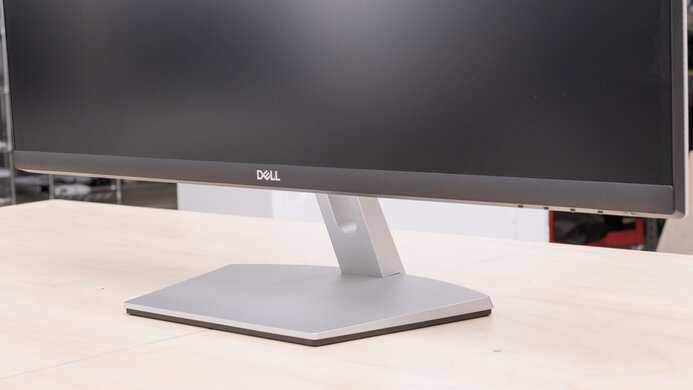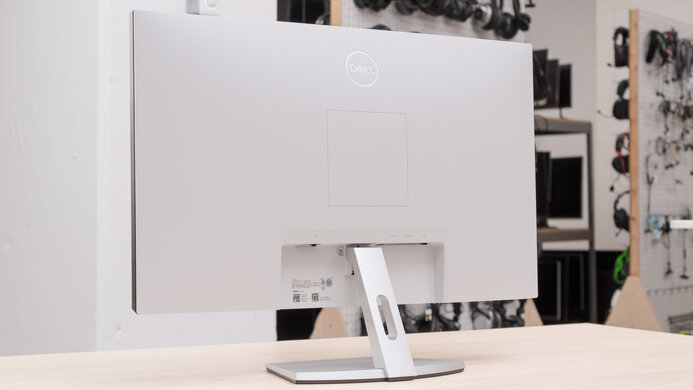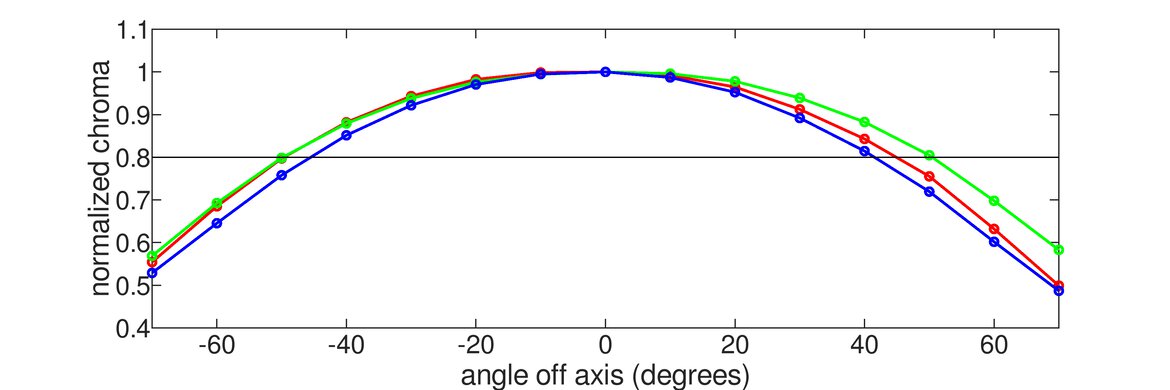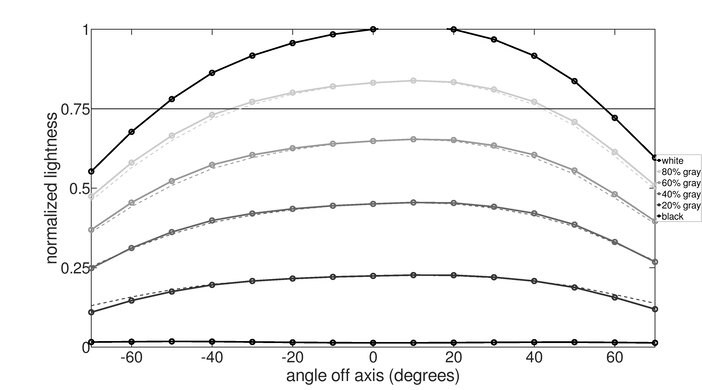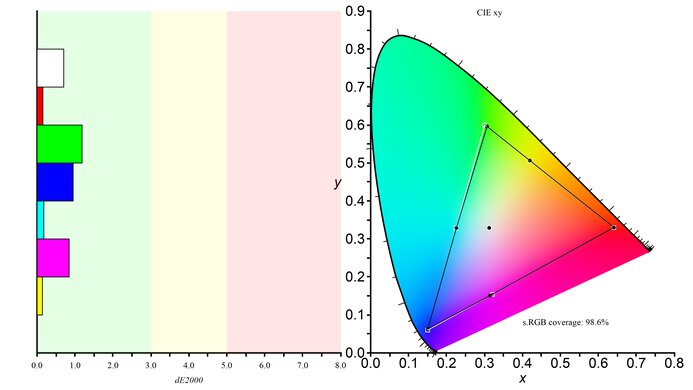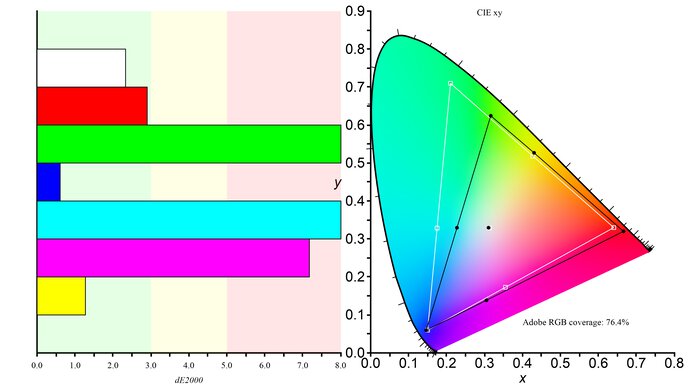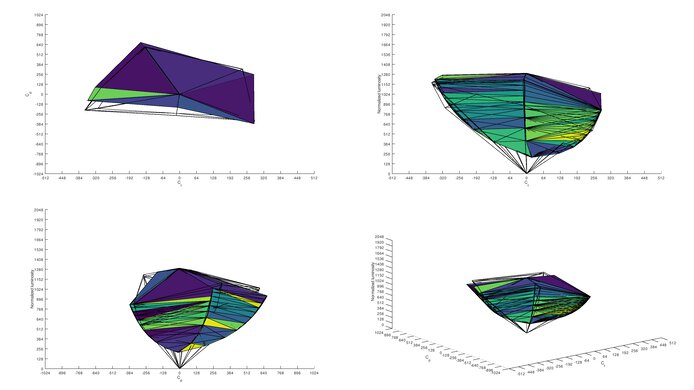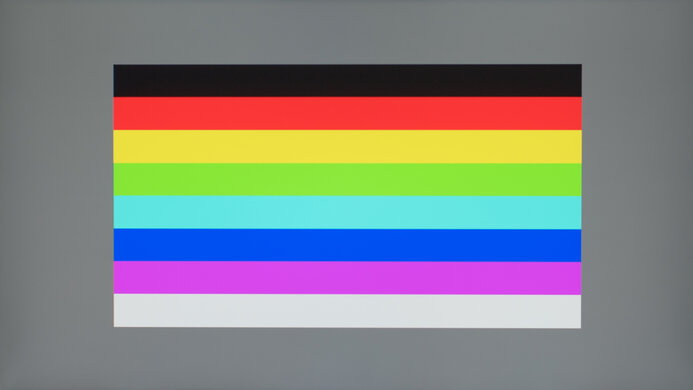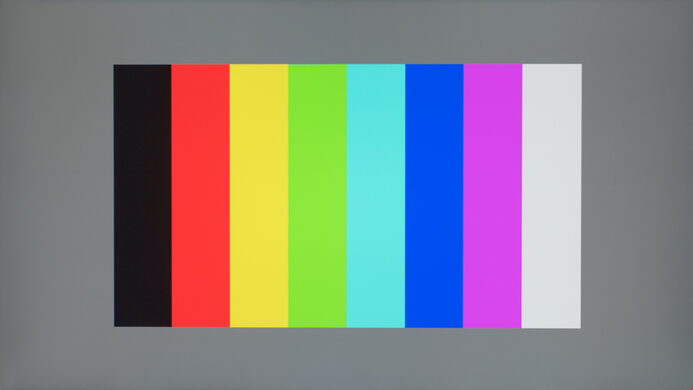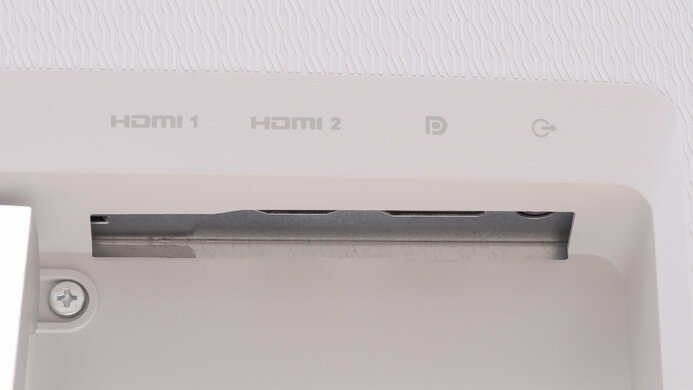The Dell S2721D is a decent 1440p monitor that's well-suited for office use and some casual gaming. It has a 27 inch screen that provides plenty of space for multitasking, and wide viewing angles to make it easy to share work or content. It has low input lag, decent response time, and a 75Hz refresh rate that helps make motion look just a bit smoother than a typical 60Hz panel. Also, it has FreeSync support and G-SYNC compatibility to minimize screen tearing. It has great reflection handling and gets bright enough for use in well-lit rooms; however, its dark room performance isn't as good due to its low contrast ratio, which is typical of most IPS panels. Also, it lacks HDR support, and it has terrible ergonomics. On the upside, it has a flicker-free backlight that can help reduce eye strain.
Our Verdict
The Dell S2721D is an overall decent monitor. It's well-suited for work thanks to its large screen and high resolution. It provides a good gaming experience with its low input lag and decent response time, and it also has variable refresh rate support to reduce screen tearing. It delivers good picture quality, but its low contrast ratio makes it less ideal for dark room viewing, and it doesn't support HDR. Also, it has terrible ergonomics, so it's difficult to adjust the screen for the best viewing experience.
- Wide viewing angles.
- Great reflection handling.
- Excellent gray uniformity.
- Low contrast ratio.
- Terrible ergonomics.
- Doesn't get bright enough to overcome intense glare.
The Dell S2721D is a good office monitor. It has an IPS panel with wide viewing angles, and it gets bright enough to fight glare in most lighting conditions. It has a large screen size and a high resolution, allowing you to have multiple windows opened side-by-side. Its 75Hz refresh rate makes the desktop experience feel more fluid, like when scrolling through documents or dragging windows. Unfortunately, it has terrible ergonomics, as it only has a tilt adjustment.
- Wide viewing angles.
- Great reflection handling.
- Excellent gray uniformity.
- Terrible ergonomics.
- Doesn't get bright enough to overcome intense glare.
The Dell S2721D is good for gaming. It has low input, decent response time, and a 75Hz refresh rate that helps make motion look more fluid than a typical 60Hz panel. Also, it has FreeSync support and G-SYNC compatibility to reduce screen tearing. It isn't the best choice for dark room gaming due to its low contrast ratio, and its bad ergonomics make it hard to adjust the screen to your optimal viewing position.
- Wide viewing angles.
- VRR support.
- Great reflection handling.
- Excellent gray uniformity.
- Low contrast ratio.
- Terrible ergonomics.
- Doesn't get bright enough to overcome intense glare.
The Dell S2721D is decent for media consumption. Its 27 inch screen and high resolution help deliver an immersive viewing experience. It provides good visibility in well-lit rooms and handles reflections well. Sadly, it has a low contrast ratio, doesn't support HDR, and its bad ergonomics make it less ideal for sharing content.
- Wide viewing angles.
- Great reflection handling.
- Excellent gray uniformity.
- Low contrast ratio.
- Terrible ergonomics.
- Doesn't get bright enough to overcome intense glare.
The Dell S2721D is decent for content creation. It has a large screen size and a high resolution, allowing you to see your work in great detail. Its IPS panel has wide viewing angles, so images remain accurate when viewed from the side. It has an excellent color gamut, with nearly full coverage of the sRGB color space. Unfortunately, it's difficult to place the screen to your preferred viewing position or share your work due to its bad ergonomics.
- Wide viewing angles.
- Great reflection handling.
- Excellent gray uniformity.
- Low contrast ratio.
- Terrible ergonomics.
- Doesn't get bright enough to overcome intense glare.
The Dell S2721D doesn't support HDR.
Check Price
Differences Between Sizes And Variants
We tested the Dell S2721D, only available in a 27 inch size. There's a Dell 2721DS variant that has a better stand that allows for swivel and rotation to portrait mode, and we expect most of our results to be valid for that model as well. There are many monitors in Dell's S Series, some of which you can see in the table below.
| Model | Size | Resolution | Refresh Rate | Note |
|---|---|---|---|---|
| S2721D | 27" | 2560 x 1440 | 75Hz | |
| S2721DS | 27" | 2560 x 1440 | 75Hz | swivel, portrait mode |
| S2721QS | 27" | 3840 x 2160 | 60Hz | swivel |
| S2721H | 27" | 1920 x 1080 | 75Hz |
If someone comes across a different type of panel or if their Dell S2721D doesn't correspond to our review, let us know, and we'll update the review. Note that some tests, such as gray uniformity, may vary between individual units.
Our unit of the Dell S2721D was manufactured in July 2020; you can see the label here.
Popular Monitor Comparisons
The Dell S2721D is a decent monitor overall. However, its bad ergonomics make it harder to place the screen to your optimal viewing position and isn't ideal for sharing work or content. There are much better options in its price range, such as the ASUS ProArt Display PA278QV. For more options, check out our recommendations for the best office monitors, the best budget monitors, and the best 1440p monitors.
Overall, the Dell S2721DGF is significantly better than the Dell S2721D. The S2721DGF is a better choice for gaming, as it has a faster response time, lower input lag, and a much higher refresh rate. It also has better ergonomics, wider viewing angles, and supports HDR. However, the S2721D has better screen uniformity and color accuracy out-of-the-box.
The Dell S2721D is much better than the Samsung T55. The Dell has a higher resolution, much wider viewing angles, and much better reflection handling. On the flip side, the Samsung has a VA panel with a much higher contrast ratio, allowing it to produce deeper blacks.
The ASUS ProArt Display PA278QV is much better than the Dell S2721D. The ASUS has significantly better ergonomics, it gets brighter, and has wider viewing angles. It also has better color accuracy out-of-the-box, faster response time, and a Black Frame Insertion feature. The Dell has better reflection handling and a slightly better SDR color gamut.
Overall, the Dell S2721D is better than the Lenovo Q27q-10. The Dell has faster response time, better color accuracy, and a better color gamut. It also has better reflection handling and gets brighter. On the other hand, the Lenovo is a thinner monitor.

We buy and test more than 30 monitors each year, with units that we buy completely on our own, without any cherry-picked units or samples. We put a lot into each unbiased, straight-to-the-point review, and there's a whole process from purchasing to publishing, involving multiple teams and people. We do more than just use the monitor for a week; we use specialized and custom tools to measure various aspects with objective data-based results. We also consider multiple factors before making any recommendations, including the monitor's cost, its performance against the competition, and whether or not it's easy to find.
Test Results

The Dell S2721D has a simple design that doesn't stand out. It has a full plastic build that looks a bit cheap, and the stand has extremely limited ergonomic adjustments. It has thin borders on three sides and a slightly thicker bottom bezel. The stand's base doesn't take up too much space, and because it's flat, you can still place things on top.
Update 01/20/2021: For consistency, we've changed the height adjustment from N/A to '0.0'. The score has been adjusted accordingly.
Unfortunately, the Dell S2721D has terrible ergonomics. It only allows for tilt adjustment, and the range is pretty narrow. The Dell S2721DS is a variant with better ergonomics, adding swivel and rotation to portrait mode; however, it's more expensive. If you want a monitor with exceptional ergonomics, check out the ASUS ProArt Display PA278CV.
The back of the monitor is plain. It can be VESA-mounted, but it doesn't have a quick-release feature. There's a small cutout on the stand for cable management.
This monitor doesn't have a local dimming feature. The video above is provided for reference only.
Good SDR peak brightness. It's incredibly consistent across different content, and it's bright enough to provide good visibility in most lighting conditions. However, it may struggle to overcome glare in very bright, sunny rooms.
We measured the SDR peak brightness after calibration, using the 'Custom Color' Picture Mode.
This monitor doesn't support HDR.
The Dell S2721D has good horizontal viewing angles. Images remain accurate when viewed from the side, great for sharing work or content.
Outstanding vertical viewing angle. This is important if you tend to sit very close to the screen or have the screen mounted above eye level.
Gray uniformity on our unit of the Dell S2721D is excellent. The top corners and the sides appear darker, but there's almost no dirty screen effect. Uniformity is better in dark scenes.
Note that gray uniformity can vary between units.
Before calibration, the color accuracy is mediocre. Most colors are inaccurate, and the white balance is visibly off. The color temperature is much warmer than our 6500K target, resulting in a reddish tint. Gamma doesn't follow the sRGB curve, making dark scenes too dark and bright scenes too bright.
Note that color accuracy can vary between units.
After calibration, the color accuracy is exceptional. Any remaining color inaccuracies shouldn't be visible to the naked eye. White balance is nearly perfect, and the color temperature is much closer to our target, though slightly on the cooler side. Gamma is much better, but both dark and bright scenes are over-brightened.
You can download our ICC profile calibration here. This is provided for reference only and should not be used, as the calibration values vary per individual unit even for the same model due to manufacturing tolerances.
The Dell S2721D has an excellent SDR color gamut. It has near full coverage of the sRGB color space used in most content, and good coverage of the Adobe RGB color space, mostly used for photo editing.
This monitor doesn't support HDR.
This monitor doesn't support HDR.
There's a tiny amount of image retention after exposing a high-contrast image for ten minutes, but it dissipates pretty quickly and shouldn't be an issue for most people.
Note that image retention can vary between units.
| Overdrive Setting | Response Time Chart | Response Time Tables | Motion Blur Photo |
| Normal | Chart | Table | Photo |
| Fast | Chart | Table | Photo |
| Extreme | Chart | Table | Photo |
The Dell S2721D has a decent response time at its maximum refresh rate. As a result, there's a slightly longer blur trail behind fast-moving objects, particularly in dark scenes where transitions are slower. The best overdrive setting is 'Normal', which provides the best performance with no overshoot.
| Overdrive Setting | Response Time Chart | Response Time Tables | Motion Blur Photo |
| Normal | Chart | Table | Photo |
| Fast | Chart | Table | Photo |
| Extreme | Chart | Table | Photo |
The response time at 60Hz is decent. It's slightly better than at the maximum refresh rate, and there's only a tiny amount of overshoot. The best overdrive setting is also 'Normal'. The 'Fast' and 'Extreme' settings cause a significant amount of overshoot and aren't recommended.
This monitor doesn't have a Black Frame Insertion feature.
The Dell S2721D has a 75Hz refresh rate that helps make motion look a bit smoother than a typical 60Hz panel. It supports FreeSync natively to reduce screen tearing when gaming and is compatible with G-SYNC as well. However, G-SYNC only works over DisplayPort.
The Dell S2721D has exceptionally low input lag, resulting in a responsive desktop experience.
This monitor's 27 inch screen provides plenty of space for multitasking and it has a high resolution to render text clearly.
There are only a few additional features on the Dell S2721D, including:
- Timer: Puts a timer on the screen.
- OSD Lock: Locks the on-screen menu to prevent accidental presses.


